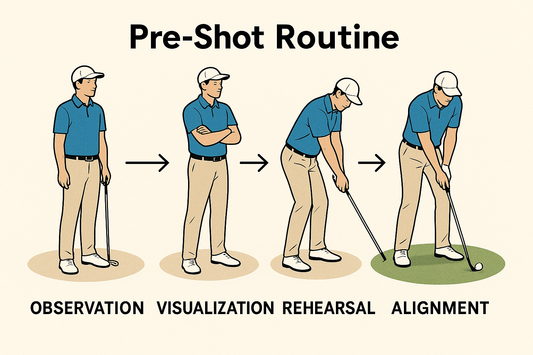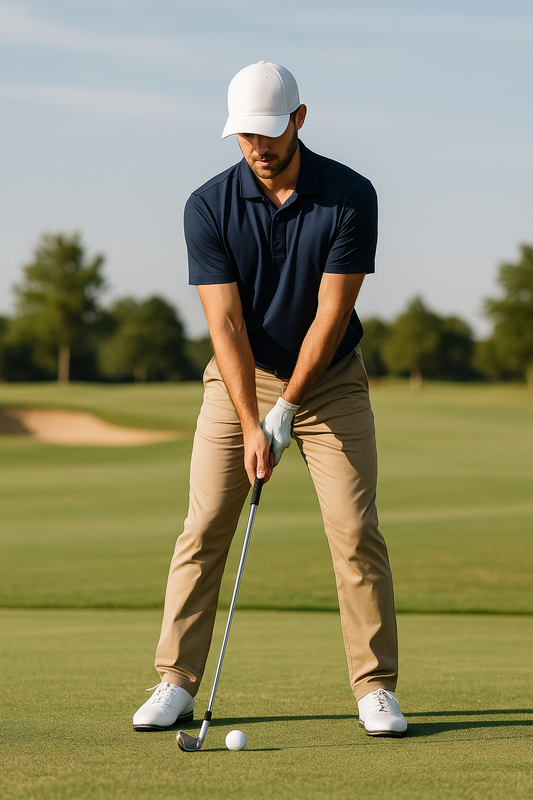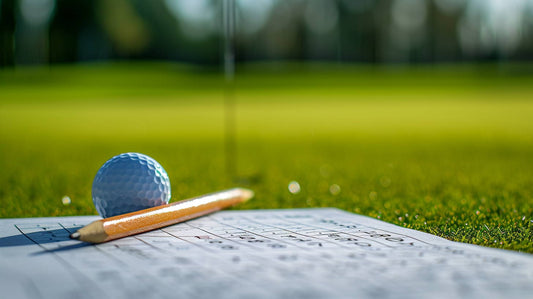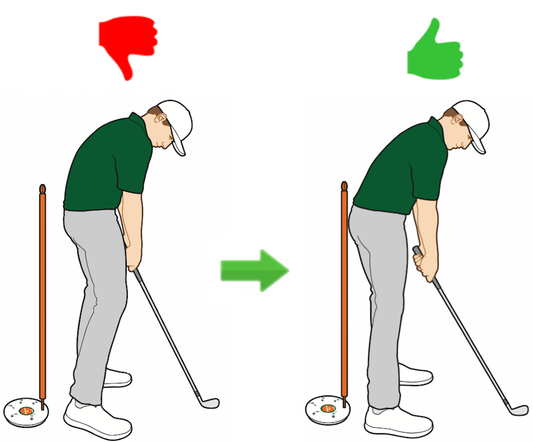Author: WhyGolf WhysGuy
We want to preface this guide with the acknowledgment that neither WhysGuy nor anyone from the WhyGolf team claims to know everything about the golf swing. We don’t want anyone to treat what we say here as gospel. While much of what we’ll say is a reflection of decades of dialogue with PGA instructors and players, we’re always learning and we understand that knowledge about the sport of golf will continue to evolve over time.
In this post, WhysGuy will discuss:
- What swaying is and how it can negatively affect your ball-striking.
- 3 practical tips to stop swaying in your golf swing.
What is Swaying in the Golf Swing?
It seems reasonable to assume that sliding the whole body away and back toward the target would produce added power in the golf swing. The problem with doing this, however, is that it makes timing the swing extremely challenging.
Swaying in golf is generally defined as excessive lateral movement with the lower body. If you find yourself swaying, it's highly likely you're leaving consistency and distance on the table. Below, you'll find three practical steps that will help you stop swaying in your golf swing.
How to Stop Swaying
1. Rotate Your Trail Foot Open at Address
- Golfers often have limited hip mobility in their trail hip, which can make it difficult to rotate effectively in the backswing. As a result, golfers often end up sliding laterally with the hips in the backswing.
- Rotating your trail foot (right foot for right-handers) open slightly at setup will allow you to rotate into your right hip more easily.
2. Improve Your Pressure Shift
- Instead of letting your hips slide away from the target, focus on applying pressure into the ground with your trail foot as you take the club back.
- When you apply pressure into the ground with your trail foot, it will be easier to keep your hips from sliding. You may also find it easier to generate power in your golf swing.
- Learn more how to pressure shift here.
3. Use an Alignment Rod as a Reference Point
- Stand an alignment rod vertically so it's just outside your trail hip at address.
- Make sure you don't slide into the alignment rod in your backswing.
- The WhyGolf Alignment Disc can be a useful tool if you want to be able to stand your alignment rods at specific angles indoors or outdoors.
How to Stop Swaying in Golf Swing - Key Takeaways:
- Swaying in the golf swing refers to excessive lateral movement with the lower body and can cause timing issues.
- To stop swaying, consider rotating your trail foot open at setup to facilitate better rotation into your trail hip in your backswing.
- Improve your pressure shift by applying force to the ground with your trail foot in the backswing.
- Place an alignment rod vertically just outside your trail hip and try not to make contact with the rod during your swing.
Ready to make an investment in your golf swing? Explore our full suite of golf training aids here.
How do I stop swaying?
Swaying in the golf swing can be avoided by maintaining proper balance and stability. Maintain good posture throughout the swing and keep your weight evenly distributed on both feet. Additionally, during the swing, concentrate on transferring your weight from your back foot to your front foot in a smooth, gradual motion. Using a weighted club or incorporating balance training exercises into your routine can also aid in improving stability and preventing swaying. Finally, it is critical to be aware of your body position and to keep your gaze fixed on the target. By using these tips, you can effectively stop swaying in your golf swing and improve your game.
What is swaying in the golf swing?
Swaying is the lateral movement of the body during the golf swing that causes a loss of balance and stability. It happens when the body moves away from the target line, causing an incorrect weight shift. Swaying can have a negative impact on the golf shot, resulting in decreased accuracy and distance, as well as discomfort and potential injury. To avoid swaying, maintain balance and stability throughout the swing by keeping the body aligned with the target line and distributing weight evenly on both feet. Understanding and dealing with swaying in your golf swing can help you improve your overall performance and reach your full potential on the course.
How does a proper pressure shift help solve swaying in the golf swing?
Swaying in the golf swing can be avoided with proper pressure shift. Swaying happens when the body moves away from the target line, resulting in an incorrect weight shift. To avoid this, the golfer should concentrate on shifting their weight from back foot to front foot during the swing. This pressure shift should be gradual and smooth, with no abrupt movements that could cause swaying. Maintaining proper posture and balance throughout the swing can also aid in preventing swaying. Incorporating balance and stability exercises into your training routine can also help you make the proper pressure shift and avoid swaying in your golf swing.
Why should I stop swaying?
Swaying in your golf swing can be detrimental to your game. It can lead to reduced shot accuracy and distance, as well as discomfort and injury. To avoid swaying, keep your balance and stability throughout the swing. This can be accomplished by distributing your weight evenly across both feet and aligning your body with the target line. Stability can also be improved by using a weighted club or balance training exercises. You can improve your overall performance and take your game to the next level by avoiding swaying in your golf swing. Don't let swaying hold you back; take control of your golf swing and stop swaying today!
What benefits will I experience if I learn how to stop swaying in my golf swing?
Learning how to stop swaying in your golf swing can improve your game significantly. Among the most noticeable advantages are improved shot accuracy and increased shot distance. You can avoid swaying and achieve more consistent and accurate shots by maintaining a stable body position and proper weight shift. Furthermore, avoiding swaying can reduce discomfort and injury risk, allowing you to play the course with greater ease and comfort. Finally, improved confidence in your swing and shots can increase your enjoyment of the game. Don't let swaying hold you back; instead, learn how to stop it and reap the benefits for yourself!
What does swaying in the golf swing cause?
Swaying in the golf swing can cause a number of issues, such as poor contact, swing path issues, and loss of power.
The fastest way to stop swaying is to work on your weight and pressure shifts. Our new Pressure Plate + Power Wedge is the perfect tool to help you learn how to push into the ground instead of pushing laterally.
What are the best drills to stop swaying in the golf swing?
To stop swaying in your golf swing, focusing on drills that promote stability and proper weight transfer is essential. Using our Pressure Plate is an excellent way to refine this aspect of your swing. Here are some of the best drills:
Mirror Drill with the Pressure Plate
- Setup: Stand in front of a mirror with the WhyGolf Pressure Plate under your feet.
- Focus: Without a ball, practice your swing slowly while watching yourself in the mirror. Concentrate on keeping your head and upper body steady, avoiding any lateral movement.
- Pressure Plate Action: As you initiate your backswing, focus on tipping the Pressure Plate to your trail side (right side for right-handed golfers) without allowing your body to sway laterally. This ensures that your weight is shifting correctly without losing your center of balance.
- Repetition: Repeat this drill slowly, focusing on controlled movements. The Pressure Plate will provide instant feedback if you begin to sway, helping you correct it immediately.
Check Out Our YouTube Channel For Drills and Tips









